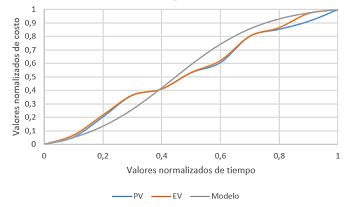Modelo logístico para aproximar Curvas S de planeación de proyectos de alcantarillado
DOI:
https://doi.org/10.13140/RG.2.2.22509.33769Palabras clave:
curva S, ecuación logística, planeación de proyectos de construcción, control de obrasResumen
Los proyectos de ingeniería tienen un plan de actividades a realizar en un tiempo inicial estimado, el cual se contrasta posteriormente con el tiempo real que efectivamente demora la ejecución del proyecto. Este plan inicial es de suma importancia tanto para el constructor como para la entidad contratante de la obra, ya que representa una relación directa de los costos de cada etapa y el tiempo que demandan. La representación gráfica de esta relación se adopta como un recurso de planificación, y su forma es similar a la curva S, sobre este gráfico se aprecia que al inicio del proyecto los costos acumulados son crecientes, y al final del se observa que decrecen. Por tales razones, en este trabajo se presenta un modelo de ecuación logística con la que se predice la planificación de un proyecto de construcción de alcantarillado partiendo de un presupuesto dado para su ejecución y el tiempo inicial estimado. El modelo se construye a partir de una muestra representativa de proyectos de alcantarillado ejecutados en la provincia de Pichincha, y se valida empleando otros no tomados en cuenta en dicha muestra. El modelo que se propone en este trabajo, tiene como valor agregado su utilidad en la toma de decisiones por parte de los entes públicos, porque proporciona una estimación más precisa sobre el cronograma valorado del proyecto
Descargas
Citas
A. Mattos and F. Valderrama, «Métodos de planificación y control de obras: Del diagrama de barras al BIM» Barcelona, 2014
G. A. Barraza, W. E. Back, and F. Mata, «Probabilistic monitoring of project performance using SS-curves» J. Constr. Eng. Manag., vol. 126, no. April, p. 32887, 2002
G. A. Barraza, W. E. Back, and F. Mata, «Probabilistic Forecasting of Project Performance Using Stochastic S Curves» J. Constr. Eng. Manag., vol. 130, no. 1, pp. 25–32, 2004
D. F. Cioffi, «A tool for managing projects: An analytic parameterization of the S-curve» Int. J. Proj. Manag., vol. 23, no. 3, pp. 215–222, 2005
L. Chao and C. Chien, «Estimating Project S-Curves Using Polynomial Function and Neural Networks» J. Constr. Eng. Manag., vol. 135, no. 3, pp. 169–177, 2009
L. C. Chao and C. F. Chien, «A Model for Updating Project S-curve by Using Neural Networks and Matching Progress» Autom. Constr., vol. 19, no. 1, pp. 84–91, 2010
Y.-M. Cheng, C.-H. Yu, and H.-T. Wang, «Short-Interval Dynamic Forecasting for Actual S -Curve in the Construction Phase» J. Constr. Eng. Manag., vol. 137, no. 11, pp. 933–941, 2011
M. Chiao Lin, H. Ping Tserng, S. Ping Ho, and D. L. Young, «A novel dynamic progress forecasting approach for construction projects» Expert Syst. Appl., vol. 39, no. 3, pp. 2247–2255, 2012
J. R. S. Cristóbal et al., «A Residual Grey Prediction Model for Predicting S-curves in Projects» Procedia Comput. Sci., vol. 64, pp. 586–593, 2015
A. Czarnigowska and A. Sobotka, «Time-cost relationship for predicting construction duration» Arch. Civ. Mech. Eng., vol. 13, no. 4, pp. 518–526, 2013
M. Kadry, H. Osman, and M. Georgy, «Causes of Construction Delays in Countries with High Geopolitical Risks» J. Constr. Eng. Manag., vol. 143, no. 2, p. 04016095, 2017

Publicado
Cómo citar
Número
Sección
Las opiniones expresadas por los autores no necesariamente reflejan la postura del editor de la publicación ni de la UCLA. Se autoriza la reproducción total o parcial de los textos aquí publicados, siempre y cuando se cite la fuente completa y la dirección electrónica de esta revista. Los autores(as) tienen el derecho de utilizar sus artículos para cualquier propósito siempre y cuando se realice sin fines de lucro. Los autores(as) pueden publicar en internet o cualquier otro medio la versión final aprobada de su trabajo.






.png)




